Smoking Intervention: Education, Strategies, and Public Health Report
VerifiedAdded on 2022/11/30
|10
|957
|168
Report
AI Summary
This report provides an overview of smoking intervention strategies and their impact on public health. It begins with an introduction to the dangers of smoking and the prevalence of smoking in the UK, citing relevant statistics from 2019. The report then discusses the importance of increasing awareness and commitment among healthcare providers regarding smoking cessation. It outlines the aims and objectives of smoking intervention programs, including behavior change strategies and the use of various models such as the Trans theoretical model and the Health Belief Model. The report explores different approaches to smoking cessation, including psychosocial interventions, and highlights the challenges of maintaining long-term abstinence. It concludes with a discussion of future developments in technology-based interventions and provides a list of references to support the information presented.
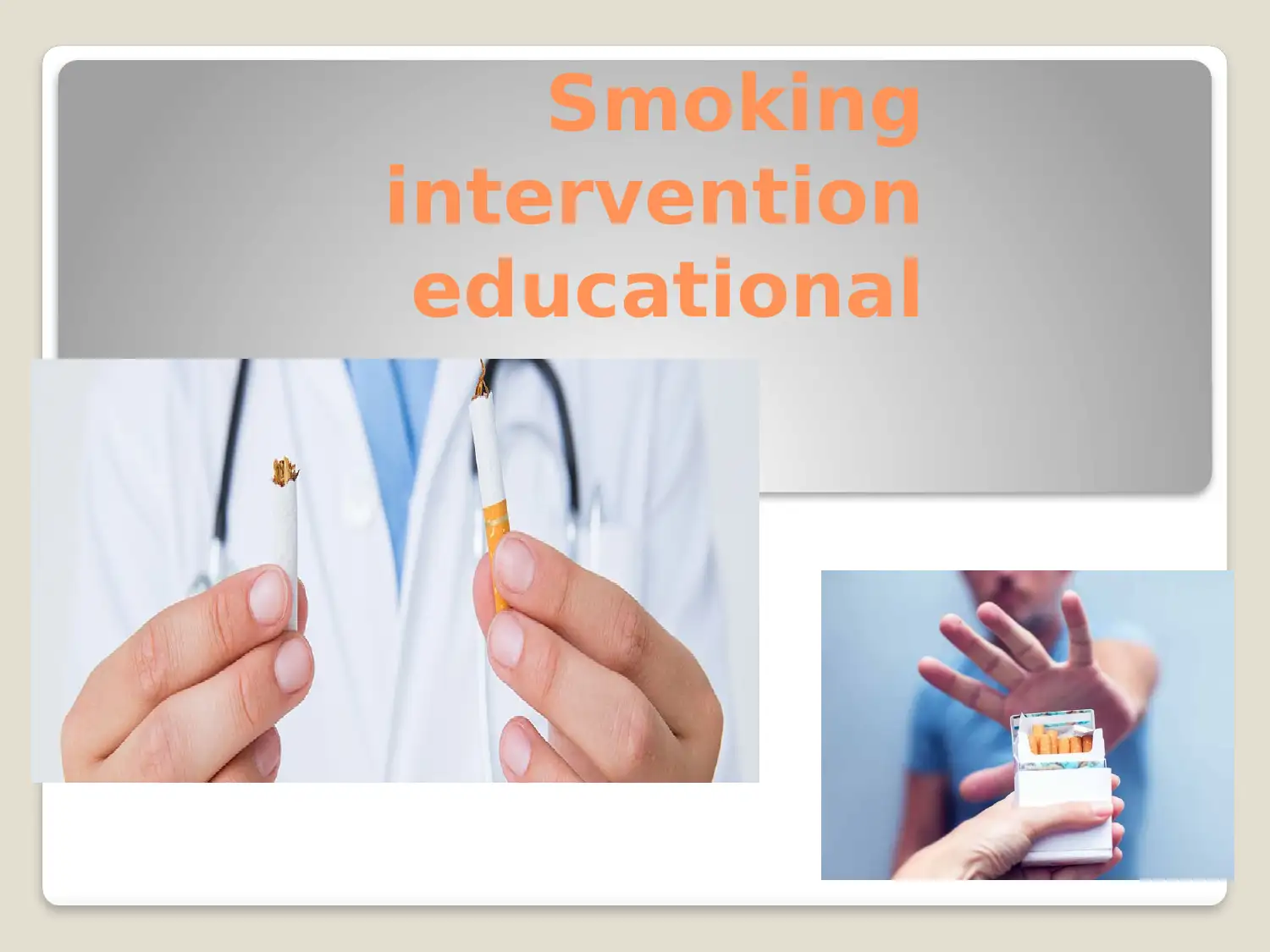
Smoking
intervention
educational
intervention
educational
Paraphrase This Document
Need a fresh take? Get an instant paraphrase of this document with our AI Paraphraser

Introduction
Roll-ups are similarly really perilous more
risky without channels.
Smoking stogies or lines is additionally
terrible for your wellbeing.
Roll-ups are similarly really perilous more
risky without channels.
Smoking stogies or lines is additionally
terrible for your wellbeing.
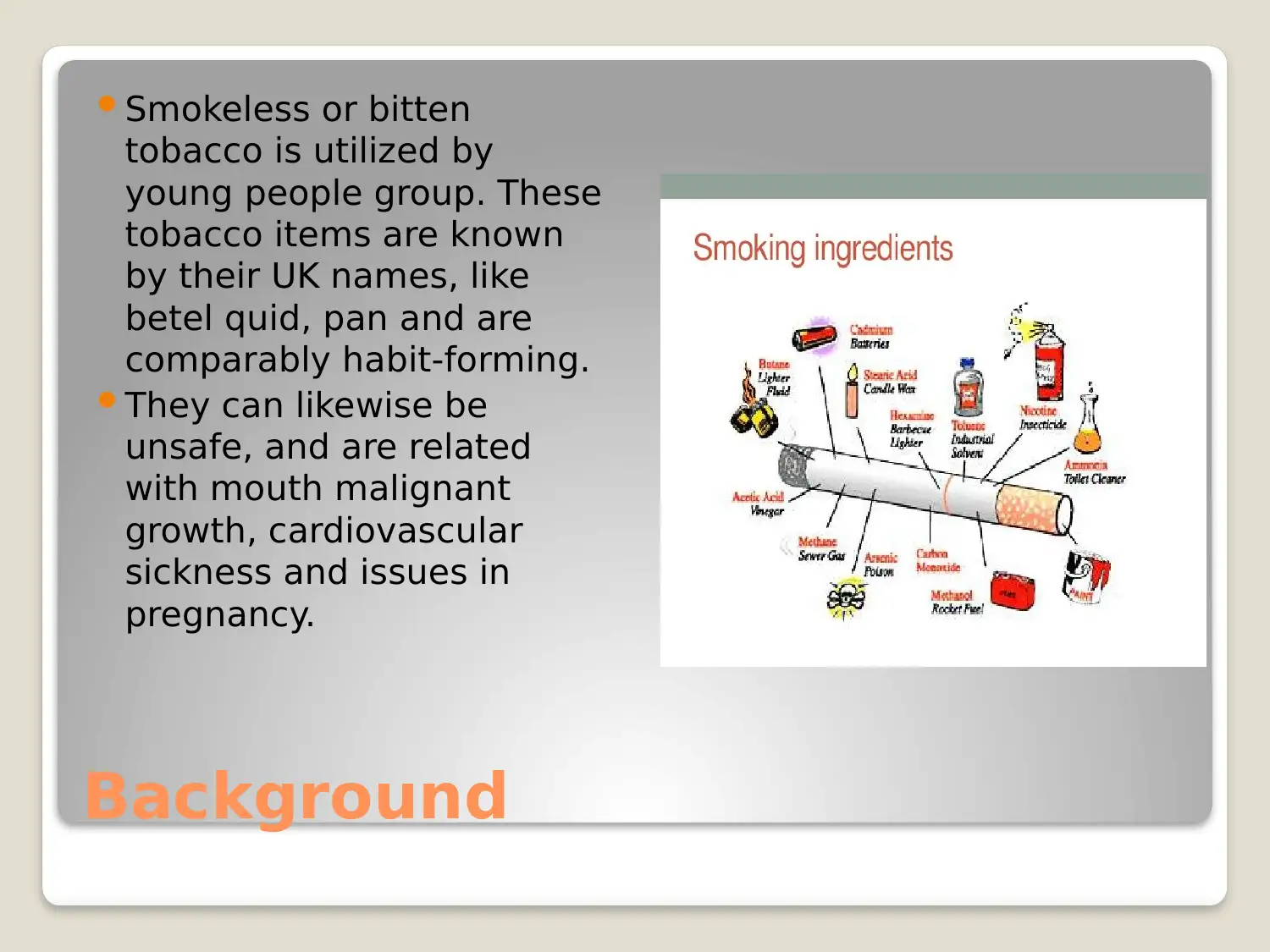
Background
Smokeless or bitten
tobacco is utilized by
young people group. These
tobacco items are known
by their UK names, like
betel quid, pan and are
comparably habit-forming.
They can likewise be
unsafe, and are related
with mouth malignant
growth, cardiovascular
sickness and issues in
pregnancy.
Smokeless or bitten
tobacco is utilized by
young people group. These
tobacco items are known
by their UK names, like
betel quid, pan and are
comparably habit-forming.
They can likewise be
unsafe, and are related
with mouth malignant
growth, cardiovascular
sickness and issues in
pregnancy.
⊘ This is a preview!⊘
Do you want full access?
Subscribe today to unlock all pages.

Trusted by 1+ million students worldwide

Statics of UK cause of smoking
In the UK, in 2019, 14.1%
of individuals matured 18
years or more smoked
cigarettes, which likens to
around 6.9 million
individuals in the
populace, in view of our
gauge from the Annual
Population Survey (APS).
The extent of current
smokers in the UK has
fallen fundamentally from
14.7% in 2018 to 14.1% in
2019.
In the UK, in 2019, 14.1%
of individuals matured 18
years or more smoked
cigarettes, which likens to
around 6.9 million
individuals in the
populace, in view of our
gauge from the Annual
Population Survey (APS).
The extent of current
smokers in the UK has
fallen fundamentally from
14.7% in 2018 to 14.1% in
2019.
Paraphrase This Document
Need a fresh take? Get an instant paraphrase of this document with our AI Paraphraser

Aim and objective
Increase mindfulness and commitment among
psychological wellness Suppliers on the significance
of smoking suspension
Increase attention to the advantages and
Suspension apparatuses among individuals living
with psychological instabilities and their families
Institute smoking suspension supports, for
example, working with week by week health and
smoking discontinuance gatherings;
Track discontinuance endeavors, decreases and
suspension longer than three more
Increase mindfulness and commitment among
psychological wellness Suppliers on the significance
of smoking suspension
Increase attention to the advantages and
Suspension apparatuses among individuals living
with psychological instabilities and their families
Institute smoking suspension supports, for
example, working with week by week health and
smoking discontinuance gatherings;
Track discontinuance endeavors, decreases and
suspension longer than three more
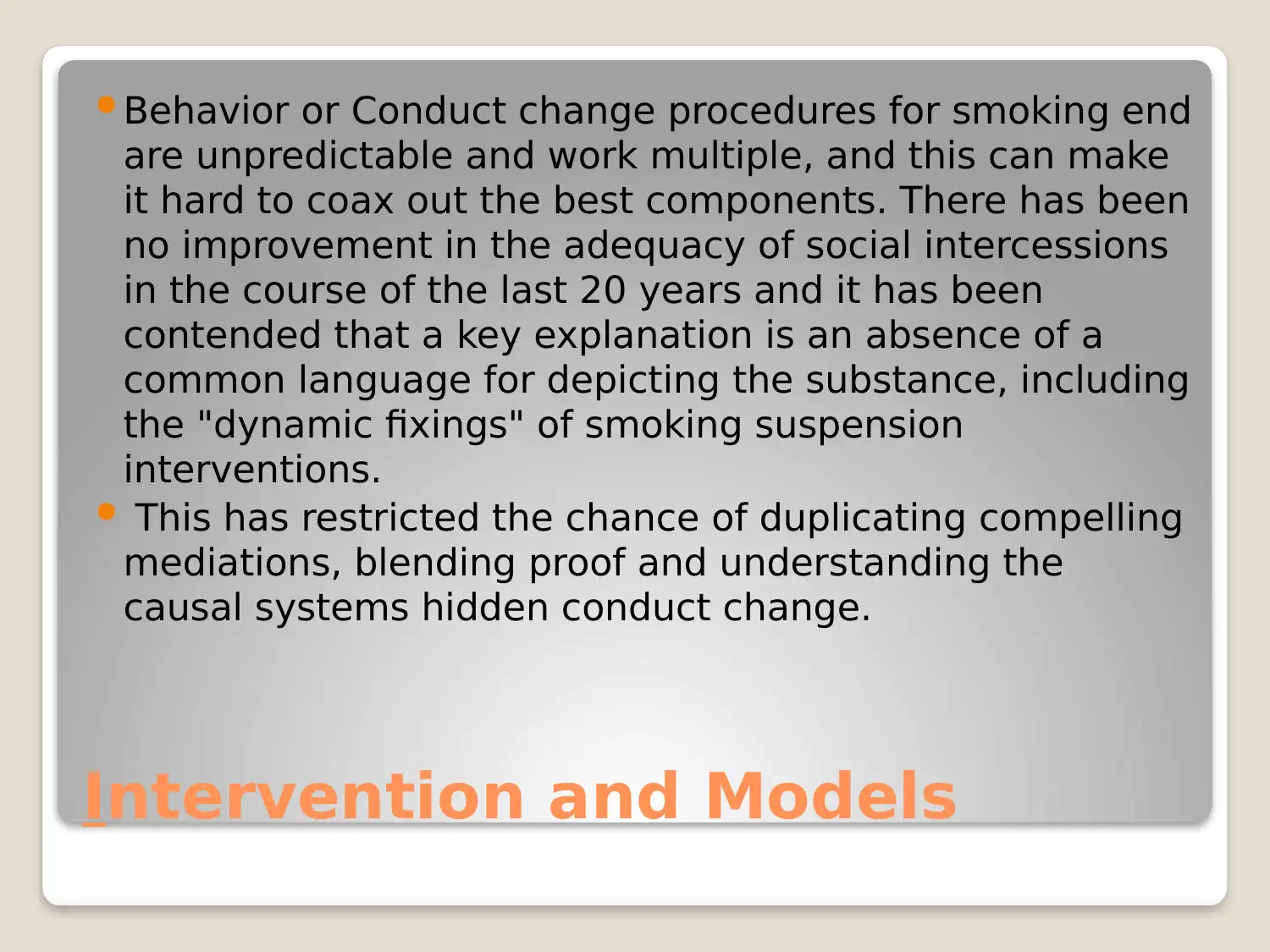
Intervention and Models
Behavior or Conduct change procedures for smoking end
are unpredictable and work multiple, and this can make
it hard to coax out the best components. There has been
no improvement in the adequacy of social intercessions
in the course of the last 20 years and it has been
contended that a key explanation is an absence of a
common language for depicting the substance, including
the "dynamic fixings" of smoking suspension
interventions.
This has restricted the chance of duplicating compelling
mediations, blending proof and understanding the
causal systems hidden conduct change.
Behavior or Conduct change procedures for smoking end
are unpredictable and work multiple, and this can make
it hard to coax out the best components. There has been
no improvement in the adequacy of social intercessions
in the course of the last 20 years and it has been
contended that a key explanation is an absence of a
common language for depicting the substance, including
the "dynamic fixings" of smoking suspension
interventions.
This has restricted the chance of duplicating compelling
mediations, blending proof and understanding the
causal systems hidden conduct change.
⊘ This is a preview!⊘
Do you want full access?
Subscribe today to unlock all pages.

Trusted by 1+ million students worldwide
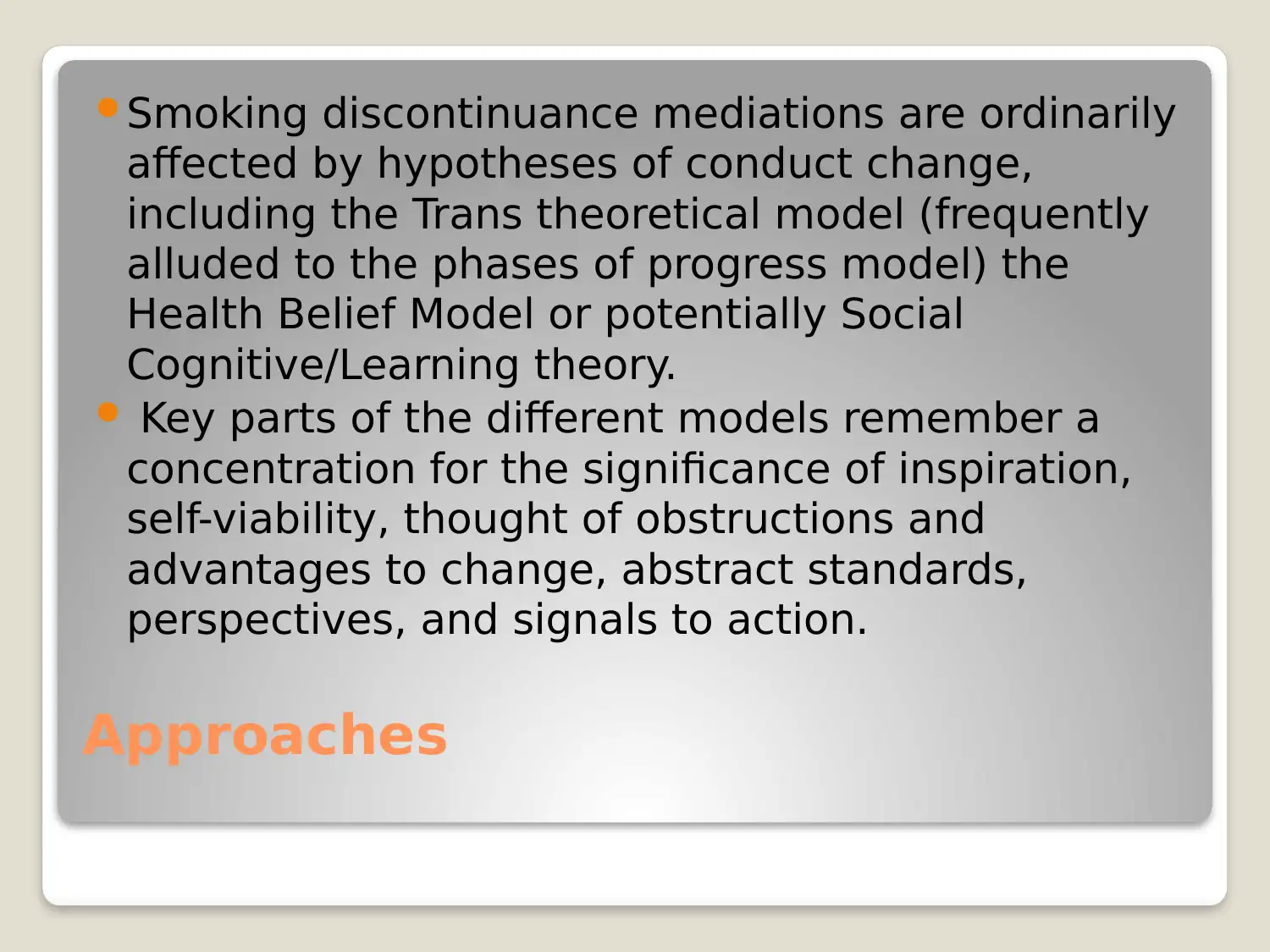
Approaches
Smoking discontinuance mediations are ordinarily
affected by hypotheses of conduct change,
including the Trans theoretical model (frequently
alluded to the phases of progress model) the
Health Belief Model or potentially Social
Cognitive/Learning theory.
Key parts of the different models remember a
concentration for the significance of inspiration,
self-viability, thought of obstructions and
advantages to change, abstract standards,
perspectives, and signals to action.
Smoking discontinuance mediations are ordinarily
affected by hypotheses of conduct change,
including the Trans theoretical model (frequently
alluded to the phases of progress model) the
Health Belief Model or potentially Social
Cognitive/Learning theory.
Key parts of the different models remember a
concentration for the significance of inspiration,
self-viability, thought of obstructions and
advantages to change, abstract standards,
perspectives, and signals to action.
Paraphrase This Document
Need a fresh take? Get an instant paraphrase of this document with our AI Paraphraser

Evaluation
Remarkable revelations in the conduct and sociologies
have expanded and developed comprehension of
psychosocial effects on the nature and treatment of
nicotine reliance, which has brought about new ways
to deal with social treatment.
It has gotten clear that, as intense nicotine withdrawal
disperses as the length of the quit endeavor expands,
a few components—including discontinuous negative
enthusiastic states, rehashed desires to smoke,
reduced inspiration, and diminished self-adequacy
about stopping—can endure all through the
suspension interaction and sabotage stopping.
Remarkable revelations in the conduct and sociologies
have expanded and developed comprehension of
psychosocial effects on the nature and treatment of
nicotine reliance, which has brought about new ways
to deal with social treatment.
It has gotten clear that, as intense nicotine withdrawal
disperses as the length of the quit endeavor expands,
a few components—including discontinuous negative
enthusiastic states, rehashed desires to smoke,
reduced inspiration, and diminished self-adequacy
about stopping—can endure all through the
suspension interaction and sabotage stopping.
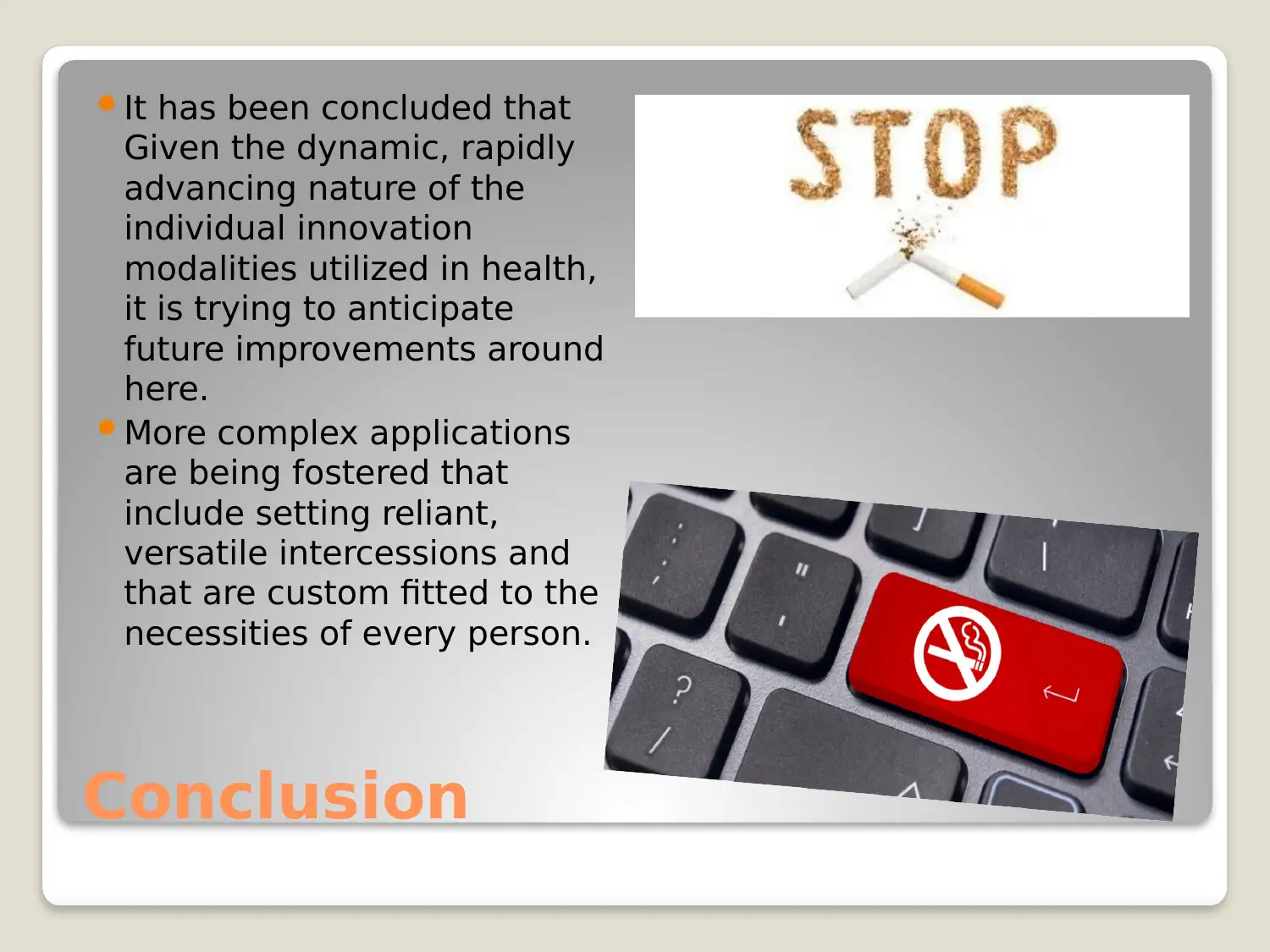
Conclusion
It has been concluded that
Given the dynamic, rapidly
advancing nature of the
individual innovation
modalities utilized in health,
it is trying to anticipate
future improvements around
here.
More complex applications
are being fostered that
include setting reliant,
versatile intercessions and
that are custom fitted to the
necessities of every person.
It has been concluded that
Given the dynamic, rapidly
advancing nature of the
individual innovation
modalities utilized in health,
it is trying to anticipate
future improvements around
here.
More complex applications
are being fostered that
include setting reliant,
versatile intercessions and
that are custom fitted to the
necessities of every person.
⊘ This is a preview!⊘
Do you want full access?
Subscribe today to unlock all pages.

Trusted by 1+ million students worldwide

References
Boyd, K.A., Briggs, A.H., Bauld, L., Sinclair, L. and Tappin, D., 2016. Are financial incentives cost‐
effective to support smoking cessation during pregnancy?. Addiction, 111(2), pp.360-370.
Naughton, F., Cooper, S., Foster, K., Emery, J., Leonardi‐Bee, J., Sutton, S., Jones, M., Ussher, M.,
Whitemore, R., Leighton, M. and Montgomery, A., 2017. Large multi‐centre pilot randomized
controlled trial testing a low‐cost, tailored, self‐help smoking cessation text message intervention for
pregnant smokers (MiQuit). Addiction, 112(7), pp.1238-1249.
Naughton, F., Cooper, S., Foster, K., Emery, J., Leonardi‐Bee, J., Sutton, S., Jones, M., Ussher, M.,
Whitemore, R., Leighton, M. and Montgomery, A., 2017. Large multi‐centre pilot randomized
controlled trial testing a low‐cost, tailored, self‐help smoking cessation text message intervention for
pregnant smokers (MiQuit). Addiction, 112(7), pp.1238-1249.
Ward, E., Cox, S., Dawkins, L., Jakes, S., Holland, R. and Notley, C., 2018. A qualitative exploration of
the role of vape shop environments in supporting smoking abstinence. International journal of
environmental research and public health, 15(2), p.297.
Hastie, C.E., Mackay, D.F., Ho, F., Celis-Morales, C.A., Katikireddi, S.V., Niedzwiedz, C.L., Jani, B.D.,
Welsh, P., Mair, F.S., Gray, S.R. and O’Donnell, C.A., 2020. Vitamin D concentrations and COVID-19
infection in UK Biobank. Diabetes & Metabolic Syndrome: Clinical Research & Reviews, 14(4), pp.561-
565.
Niedzwiedz, C.L., Green, M.J., Benzeval, M., Campbell, D., Craig, P., Demou, E., Leyland, A., Pearce, A.,
Thomson, R., Whitley, E. and Katikireddi, S.V., 2021. Mental health and health behaviours before and
during the initial phase of the COVID-19 lockdown: longitudinal analyses of the UK Household
Longitudinal Study. J Epidemiol Community Health, 75(3), pp.224-231.
Boyd, K.A., Briggs, A.H., Bauld, L., Sinclair, L. and Tappin, D., 2016. Are financial incentives cost‐
effective to support smoking cessation during pregnancy?. Addiction, 111(2), pp.360-370.
Naughton, F., Cooper, S., Foster, K., Emery, J., Leonardi‐Bee, J., Sutton, S., Jones, M., Ussher, M.,
Whitemore, R., Leighton, M. and Montgomery, A., 2017. Large multi‐centre pilot randomized
controlled trial testing a low‐cost, tailored, self‐help smoking cessation text message intervention for
pregnant smokers (MiQuit). Addiction, 112(7), pp.1238-1249.
Naughton, F., Cooper, S., Foster, K., Emery, J., Leonardi‐Bee, J., Sutton, S., Jones, M., Ussher, M.,
Whitemore, R., Leighton, M. and Montgomery, A., 2017. Large multi‐centre pilot randomized
controlled trial testing a low‐cost, tailored, self‐help smoking cessation text message intervention for
pregnant smokers (MiQuit). Addiction, 112(7), pp.1238-1249.
Ward, E., Cox, S., Dawkins, L., Jakes, S., Holland, R. and Notley, C., 2018. A qualitative exploration of
the role of vape shop environments in supporting smoking abstinence. International journal of
environmental research and public health, 15(2), p.297.
Hastie, C.E., Mackay, D.F., Ho, F., Celis-Morales, C.A., Katikireddi, S.V., Niedzwiedz, C.L., Jani, B.D.,
Welsh, P., Mair, F.S., Gray, S.R. and O’Donnell, C.A., 2020. Vitamin D concentrations and COVID-19
infection in UK Biobank. Diabetes & Metabolic Syndrome: Clinical Research & Reviews, 14(4), pp.561-
565.
Niedzwiedz, C.L., Green, M.J., Benzeval, M., Campbell, D., Craig, P., Demou, E., Leyland, A., Pearce, A.,
Thomson, R., Whitley, E. and Katikireddi, S.V., 2021. Mental health and health behaviours before and
during the initial phase of the COVID-19 lockdown: longitudinal analyses of the UK Household
Longitudinal Study. J Epidemiol Community Health, 75(3), pp.224-231.
1 out of 10
Your All-in-One AI-Powered Toolkit for Academic Success.
+13062052269
info@desklib.com
Available 24*7 on WhatsApp / Email
![[object Object]](/_next/static/media/star-bottom.7253800d.svg)
Unlock your academic potential
Copyright © 2020–2025 A2Z Services. All Rights Reserved. Developed and managed by ZUCOL.
